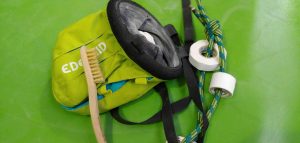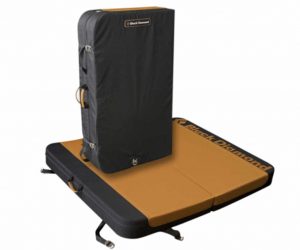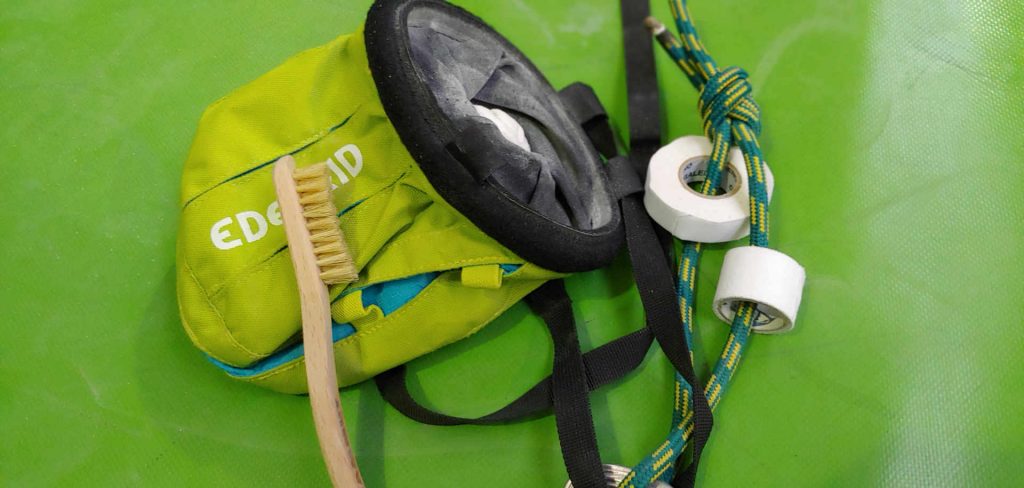Table of Contents
Bouldering is a pretty minimalistic sport. In terms of gear requirements, it’s like climbings little brother. Wild and strong, always on the move but not with a lot of baggage. Typically people ask me if they really need climbing shoes when they start bouldering. Quick Answer: No, you don’t really need climbing shoes for bouldering as a beginner. But beginner climbing shoes can be really helpful for bouldering too, make it more fun and are not that expensive. And if you climb some harder problems chances are high you will need a good pair of climbing shoes at some point.
Why climbing shoes are still a good idea
You can get climbing shoes for any style, many of them are designed for bouldering. When you chose them, you must usually compromise between some factors like:
- Tight or lose fit? Tight is better for performance om small holds, loose is more comfortable.
- Sticky rubber or firm rubber? Sticky rubber is soft and makes shoes wear down faster, but also makes them stick better to the wall. Firmer soles give you better smearing. When you press your shoes to the rock or slab and use friction alone to get a grip, that’s called smearing. Firm soles also last longer
- Thin soles are sensitive but less durable
If you’re a beginner, don’t spend too much money on shoes. Chances are they won’t last very long anyway as your footwork most likely is not perfect. In terms of fit, they should not cause pain, read my guide on climbing shoes!
Some quick advice: The tighter the fit, the better will they perform. It’s normal to have climbing shoes at least a size smaller than normal street sneakers. So make sure that they fit nice and snug, but not super painful. They will probably flex a little bit so make sure to have no dead space in the front or around your heel!
The stiffer the shoe the less tight it needs to be. If you’re advanced you can get a pair of extremely tight shoes that almost bend around your feet. They will give you extra support on small edges and holds, but it makes it harder to climb on slabs where you need to get a large portion of rubber to the wall. And they can hurt your feet, keep that in mind.
Beginner shoes are usually quite stiff, with a lot of rubber and a flat sole. They’re not super performance oriented, but feel comfortable. I would definitely get comfortable shoes in the beginning, and then buy a pair of performance shoes later on.
Some other non-essential items for bouldering
Besides climbing shoes for bouldering, some other obvious things such as a crashpad and chalk are good to have. If you boulder outdoors you also need some good functional clothes and a brush to clean rock holds. Another nice-to-have thing is a small patch of carpet to keep shoes clean and a tarp for humidity protection of your pad. Also, a guidebook and maybe a compass can be nice. And bring some water and food if your bouldering spot is a little off the tracks.
You should definitely wear loose fitting clothes – not too baggy, but tight jeans without stretch are a no-go. If you go bouldering outside, bring an extra hooded jacket or softshell jacket, as rock walls can get cold. It’s always good to wear an extra layer when you do your warm-up routine. You should get warm when warming up, after all, it’s called warm-up for a reason. When you feel your temperature rising you can start shedding layers until you feel comfortable. Don’t keep them on, otherwise, you will be soaked in sweat which is not good either.
A climbing pad, or bouldering mat, is definitely needed if you boulder outside – it absorbs the shock from falling and will keep you from being injured. Although you still need to learn to fall!
Chalk
Chalk is actually Magnesium Carbonate or MgCO₃, it’s a white powder that absorbs sweat from your hands. A lot of climbers and boulderers use it, it’s quasi a gold-standard and it serves both a practical and psychological use. Just watch some of the pro climbers religiously reaching into their chalk-bag when they work on complicated routes. If you climb you will notice a lot of sweat on your hands – this can be due to the physical activity but also because of fear. Especially common for new climbers who are not used to the height.
Chalk is great to absorb the sweat and give your hands a firm grip. Chalk itself does not increase friction, but it prevents sweat and as such it helps your hands get a firm grip on holds. Some brands of chalk actually contain a drying agent. It helps to reduce sweaty hands even further if you climb in warm temperatures. But do keep in mind that too much chalk is not too good for your skin. It’s quite the opposite actually, and continued overuse will dry out your hands and harm the upper layer of your skin.
So make sure to wash your hands when you’re done bouldering and use a good lotion to regenerate skin moisture. You can buy chalk as powder, liquid mixed with alcohol and as chalk balls. Chalk balls are round begs of mesh filled with chalk, reducing the number of particles becoming airborne when chalking your hands.
You can also use liquid chalk, which eliminates chalkdust completely. But it is even worse for your hands’ skin thanks to the ethanol it comes mixed with. It evaporates when touching your hands, leaving a thin layer of chalk in your hands. Good for a base layer of chalk too. Don’t overdo it with the chalk and bring a brush to clean some of the grips if you make a chalky mess. It’s nicer for the climbers who come after you.
Chalk Bag

This one is a must, it’s a little pouch to keep your chalk available when climbing. You can hang it to your belt or harness. You can also get a bouldering chalk bag or bucket, they are usually bigger and not designed to drag around with you. Just leave them on the ground, chalk up before you go and good. It’s also a good idea to buy an airtight box to store your supply of chalk in your house: Keeps chalk from dusting your furniture and the chalk itself stays dry.
Clothing
If you climb close to your car you probably need no extra clothing. But things look different if you actually have to hike for an hour to get to your bouldering spot. This becomes important if conditions are cold or humid or both. Don’t forget to bring:
- A warm cap or hat that covers your ears
- A pair of gloves if it’s cold – rock can make your fingers numb after only a couple of minutes climbing
- Breathable base layer with long sleeves – roll them up once you feel too hot. It’s super important to have the base layer made from some breathable material. Don’t just wear a t-shirt unless it’s in the mid of summer
- Fleece or wool jumpers for mid-layer, which you can keep wearing if it’s really cold even when climbing
- Down jackets are super light-weight and very warm, but if it rains you must wear an extra layer of breathable protection. Cold and wet down is no good!
- Shorts are nice when it’s warm, but won’t protect your legs from ticks and insect bites when it’s warm
- I really like to wear thin socks inside my climbing shoes if it’s cold – it’s uncommon but it works great for me
- Get some hiking boots for long approaches on rough terrain. They will also keep your feet warm in autumn, spring and winter, give good support to your ankles and last for years.
Brush
A brush is essential to clean boulder problems and climbing routes of excess chalk. You can get them in any color or shape, usually, a plastic or wooden brush works fine. There is a type of brush on the market with a telescoping stock, which helps to reach holds high up in the air. Don’t ever use a brush with metal bristles as they damage the rock destroy holds for climbers who climb the same route or problem later on.
Skin care products
Definitely bring some zinc oxide tape, it will protect your fingers and keep skin in working conditions. Sandpaper or pumice stone can help to minimize blisters and rough patches on your skin: If you remove it, chances are smaller to rip flakes of the skin of when going hardcore monkey style on fat holds. Your skin needs some time to adapt, by the way, so get used to having some amount of blisters on your hands. I had terrible bleeding blisters in the first weeks of bouldering. The easier your routes are the worse it is as difficult crimping finger holds are usually not easy to grip with the full palm of your hand – but beginner holds are. You should also invest some money in a good skin moisturizer or lotion. Another thing you should buy is some climbing tape. It will not only help you if you are prone to finger injuries but you can also use it to conveniently tape blisters.
The boulder crash pad
Relatively new (they became a thing in the 90s), these pads will save you from injury when falling. Before that, even short falls were potentially very dangerous. Since bouldering became really popular in the last years, sales for pads have soared too, as the pad decreases chances of a sprained ankle etc. drastically.


Since crash pads came by, some harder higher boulder problems were suddenly accessible. It’s easy to stack them or build a field of pads when a problem has a bad landing. They have another nice effect long-term: They minimize wear and tear of your knee, foot, and ankle joints as they absorb a lot of the shock from repeated falls.
Design options like color are endless, but most pads consist of one or more layers of foam which are covered in a hard rubber fabric, making them strong and durable. The hard layer is usually placed on top to spread the load of the impact, which is then absorbed by the underlying foam areas. Pads can be small (1m x 1.5m x 5cm thickness) or large for highball (very high and dangerous boulders) (3m x 2m x 15cm thickness). Most guys and girls I know like smaller pads since they are easier to haul. Make sure to buy a good pad, as the foam does the work and good foam costs more than the cheap stuff.
Pads come in two fundamental shapes: Taco and Hinge. While Taco pads have a whole section of foam which is bent in the middle for carrying, a hinge pad consists of two sections of foam connected with a hinge.

